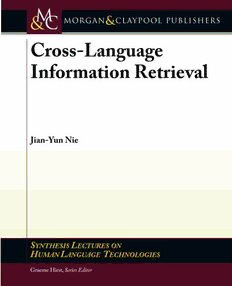
Cross-language Information Retrieval (Synthesis Lectures on Human Language Technologies) PDF
142 Pages·2010·1.374 MB·
Most books are stored in the elastic cloud where traffic is expensive. For this reason, we have a limit on daily download.
Preview Cross-language Information Retrieval (Synthesis Lectures on Human Language Technologies)
Description:
Search for information is no longer exclusively limited within the native language of the user, but is more and more extended to other languages. This gives rise to the problem of cross-language information retrieval (CLIR), whose goal is to find relevant information written in a different language to a query. In addition to the problems of monolingual information retrieval (IR), translation is the key problem in CLIR: one should translate either the query or the documents from a language to another. However, this translation problem is not identical to full-text machine translation (MT): the goal is not to produce a human-readable translation, but a translation suitable for finding relevant documents. Specific translation methods are thus required. The goal of this book is to provide a comprehensive description of the specifi c problems arising in CLIR, the solutions proposed in this area, as well as the remaining problems. The book starts with a general description of the monolingual IR and CLIR problems. Different classes of approaches to translation are then presented: approaches using an MT system, dictionary-based translation and approaches based on parallel and comparable corpora. In addition, the typical retrieval effectiveness using different approaches is compared. It will be shown that translation approaches specifically designed for CLIR can rival and outperform high-quality MT systems. Finally, the book offers a look into the future that draws a strong parallel between query expansion in monolingual IR and query translation in CLIR, suggesting that many approaches developed in monolingual IR can be adapted to CLIR. The book can be used as an introduction to CLIR. Advanced readers can also find more technical details and discussions about the remaining research challenges in the future. It is suitable to new researchers who intend to carry out research on CLIR.
See more
The list of books you might like
Most books are stored in the elastic cloud where traffic is expensive. For this reason, we have a limit on daily download.
